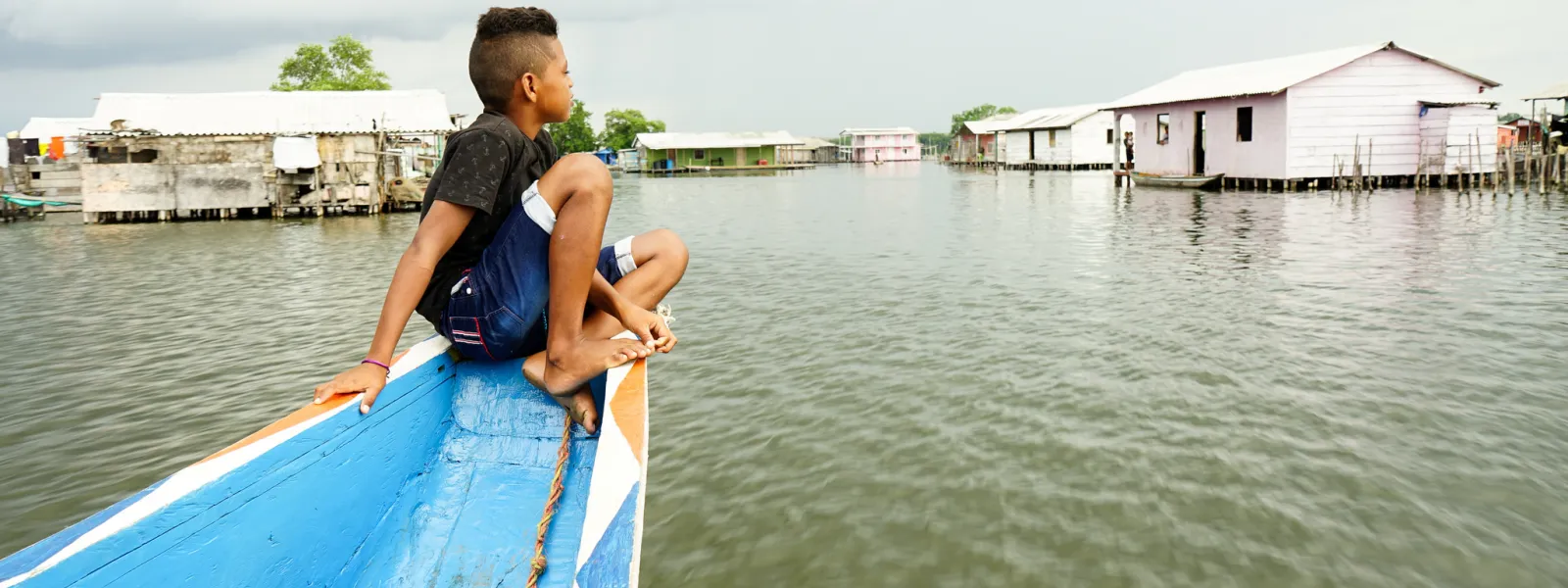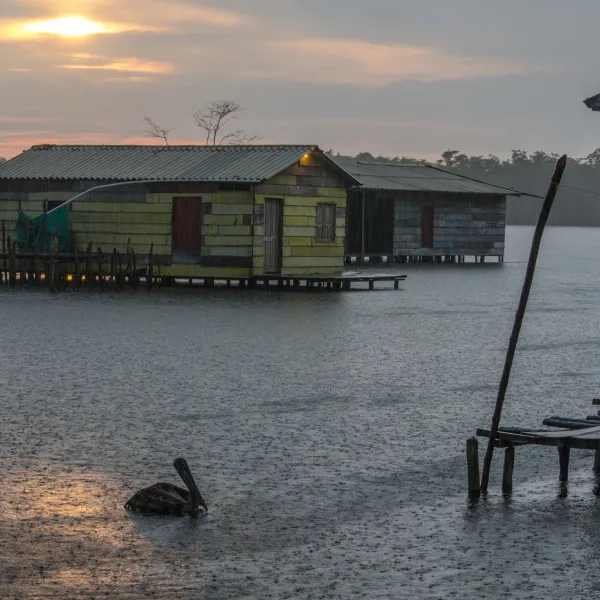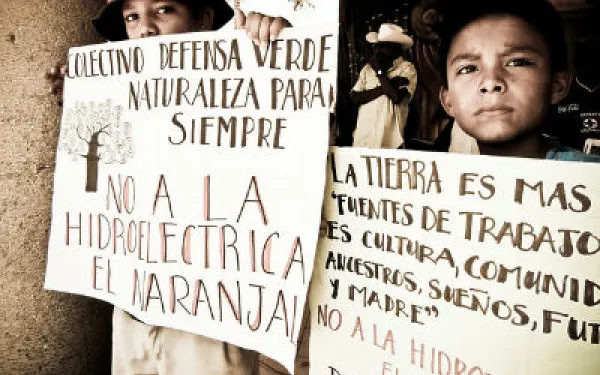
Project
Photo: Anna Laurie Miller / AIDAConserving the Ciénaga Grande de Santa Marta
Ciénaga Grande de Santa Marta, the largest and most productive coastal wetland in Colombia, covers 45,000 hectares. At the confluence of the Magdalena River and the Caribbean Sea, the site boasts an immense variety of flora and fauna, including mammals, birds and fish. Its southern tip is a beautiful sanctuary of mangroves, swamp and amphibious forest.
On the calm waters of the marsh stand the Ciénaga’s famous stilt villages, supported by pillars or simple wooden stakes and inhabited by local fishermen since 1800. In a place accessible only by water, many of the things we take for granted—being served a glass of water, quick access to a doctor—are considered luxuries. Residents depend on the natural world around them. Sadly, in recent years mass fish die-offs caused by the marsh’s degradation have threatened the livelihoods of 2,500 people who call the Ciénaga Grande home.
Illegal activities are destroying this vital ecosystem: intentionally set forest fires, deforestation of large tracks of land for agriculture and livestock, logging and burning of mangroves, and 27 kilometers of illegally built dikes.
This destruction not only devastates the local fishery; it also has global impact. Ciénaga Grande’s mangroves absorb large quantities of carbon dioxide from the atmosphere, aiding in the global fight against climate change.
The importance of the Ciénaga Grande has been recognized both nationally – the Sanctuary of Flora and Fauna Ciénaga Grande de Santa Marta is a national park – and internationally: UNESCO’s Man and the Biosphere program declared the lagoon a biosphere reserve; and the Ciénaga Grande is listed as a Wetland of International Importance under the Ramsar Convention, an intergovernmental treaty for the protection of wetlands.
AIDA and our partners are advocating for the Colombian government to fulfill its national and international obligations to protect the Ciénaga Grande. After all, millions of animals, the local community, and our global climate depend on it.
Partners:

Related projects

Virtual water: What we do not see
By Haydée Rodríguez, legal advisor, AIDA We live in an era of virtual creations. We have virtual reality, universities and conferences and even virtual pets. It’s no surprise then that the term “virtual water” is used more and more. But what does it mean and what’s it got to do with our everyday lives? Virtual water is defined as the quantity of water needed to create a certain product. This estimate takes into account the volume of water consumed and contaminated in the different stages of the manufaccturing process. The United Nations estimates our daily water requirement is 2 to 4 liters per person. But it takes 2,000 to 5,000 liters to make the food that one person needs every day. The Virtual Water Project has made estimates of the virtual water needed to make many of the products we consume daily. You can even download an application to do the calculations on your mobile phone. Here are a few numbers that caught my attention: 15,000 liters of water are needed to produce 1 kg of meat. 8,000 liters of water are needed for a pair of jeans. 1,000 liters of water are needed for 1 liter of milk. 2,500 liters of water are needed for 500 g of cheese. 25 liters of water are needed for 1 potato. 3,600 liters of water for 1 kg of rice. 109 liters of water for 1 glass of wine (125 ml). Our water footprint The virtual water calculation allows us to measure our water footprint as well. The water footprint of an inpidual, business or country is the sum total of the virtual water used in making every product and service. On a per-country basis, the calculation includes the water used for domestic and industrial purposes as well as the water used in foreign countries to produce the goods and services imported and consumed by the country's inhabitants. The map above shows the water footprint by country on a world scale (you can check out the data of every country here). It is interesting to note that developed countries like Canada that have a high level of manufacturing and imports also have a very high water footprint. Even so, according to the United Nations water availability map, not all the countries listed suffer water shortages. In general, this is becuase many products requiring high levels of water are imported and not manufactured locally, thus generating greater pressure in countries suffering from water stress: high water demand with low availability due to shortage or pollution. You can also calculate the water footprint of inpiduals taking into account social characteristics and consumption patterns. If you want to calculate yours, you can enter your data on this link. Virtual water, real action Being aware of the concepts of virtual water and water footprint is important for promoting the need for more information and transparency regarding what we consume. That makes it possible for us to change our habits and choose more sustainable products with low virtual water content. We can always ask ourselves what's behind the scenes for the pair of jeans we want to buy but may not need. Both concepts are essential for designing any strategy for protecting water and reducing the impact on aquatic ecosystems. Countries should consider the virtual water content of imported and exported products in their water resources management plans. There is still much to learn in this field. The virtual water coming from aquifers or páramos can have a higher value and impact on populations and associated ecosystems than surface waters. To have a better idea of the pressure we put on water resources we should incorporate the economic value of the environmental services offered by the difference sources into the calculation of virtual water. Virtual water is a tool we can use to understand the impact we have on natural resources. Even beyond what we can see, water is present in all our activities and decisions. By taking action to protect our water resources and making informed decisions, we can guarantee the human right of access to water for many people around the world.
Read more
Why defend the environment?
By Tania Paz, general assistant, AIDA,@TaniaNinoshka “The earth will be as the men are.” (Nahuatl proverb) “They murdered a friend of the collective in Amatlán,” read the text message I received on the afternoon of August 2. They had killed Noé Vázquez Ortiz, an artisan, farmer and member of the Defensa Verde Naturaleza para Siempre (Green Nature Forever Defense) collective, a group of citizens from Amatlán de los Reyes, a municipality in Veracruz, Mexico. Since 2011, the collective has been fighting against the construction of the El Naranjal hydropower dam, a project that will disrupt rivers and affect the livelihoods of some 30,000 people in five neighboring municipalities. Noé was killed while gathering flowers and seeds for the opening celebration of the 10th anniversary of the Mexican Movement Against Dams and in Defense of Rivers (MAPDER). I never met Noé and I’ve never visited Amatlán de los Reyes. But for the past three years I have been following the struggle of the Amatlán people to protect their land. The tragedy prompted me to ask myself: Why should we defend the environment, and what motivates people to risk their lives for it? There are important reasons why it’s essential for us to defend the environment, which I am sharing here. While this is not an exhaustive list, I think it does help at least to explain key motivations. The right to a healthy environment The right to live in a healthy environment was established in the 1972 Stockholm Declaration and reaffirmed in the Rio Declaration of 1992. This right encompasses others such as the right to life, the right to food and food security, access to drinking water and sanitation through the protection of water sources, forests and wildlife. Environmentalists are more than anything defenders of human rights, as AIDA attorney María José Veramendi has said. The defense of our identity as communities Natural resources have played an important role in the development of civilizations throughout human history. This is manifest in the construction of community culture and identity. The legends, stories, traditions and characteristics of the Mesoamerican communities, for example, are intrinsically linked to the gifts of nature. During Easter in Nicaragua, children re-enact the crucifixion of Jesus Christ in an aquatic Via Crucis (in Spanish) (Stations of the Cross) on Lake Nicaragua, the largest freshwater source in the country, while the river system is an important aspect of the famous Mexican legend of “The Weeping Woman.” In the Rarámuri territory of Mexico, “corn provides the backbone of the indigenous Sierra Tarahumara culture as it does for all ethnic groups in the country. Any changes involved in the production, consumption and distribution of the grain signifies a transformation in the social, cultural and biological persity of these ethnic groups,” says Horacio Almanza Alcade (2004, in Spanish). What will happen to our cultural wealth and identy when natural resources are depleted? Will we lose our identities as communities? These questions are worth asking. The continuity of the human species For me, defending the environment is a way to preserve the human species with a high standard of living and quality of life. In a well-known letter from 1854, Chief Seattle of the Suwamish tribe wrote in reply to an offer by US President Franklin Pierce to buy the country’s northwest territories the following: “Whatever befalls the earth, befalls the sons of the earth. If men spit upon the ground, they spit upon themselves.” Today, the harm we are inflicting on the environment comes at a great cost. According to the most recent estimates (2013) of the World Health Organization (WHO), more than two million people die each year from inhaling small particulate contaminants in the air both indoors and outdoors. Malaria kills over one million children under the age of five every year, mostly in Africa. The spread of the disease is worsened by poor water storage and handling, inadequate housing, deforestation and the loss of biopersity. Defending the environment is no easy task. At every level, whether in communities, national or international organizations, civil associations or NGOs like AIDA, tackling the problem requires many hours of work and study at the sacrifice of time away from family and friends. In many cases, environmental defense means risking lives for the sake of others, for the sake of society. Protection is needed. It is the obligation of governments and authorities at home and around the world to provide this necessary protection and support to the defenders of the environment.
Read moreProtecting the Colombian páramos: It’s more than just rules
By Carlos Lozano, legal advisor, AIDA,@CLozanoAcosta The consensus in Colombia is that páramo ecosystems are important and must be protected. These high-altitude wetlands are a source of clean water for over two million people. They play a key role in combating climate change, and they host a wealth of strategic biopersity. Half of the world’s páramos are found in Colombia, where they provide the country with 70% of its potable water [1]. Colombia’s print media, for the most part, has shown support for protecting the páramos, backed by a critical mass of congruent public opinion. Progress has been made to conserve the páramos with new regulations and public policies, but challenges remain. Hampering the conservation efforts are the poor implementation of regulations, local community protests, persuasive mining interests and, most recently, a national agrarian strike [2]. National laws incorporate provisions to protect the páramos, including a prohibition of mining activities, among other things. Unfortunately, Colombia’s Constitutional Court recently ruled against reforms to the Mining Code (Law 1382 of 2010) that included a provision expressly forbidding mining in the páramos. Despite this setback, there is a series of domestic rules that, when interpreted as a whole, retain the prohibition on mining. Other legal safeguards exist in the country’s judicial system. The Colombian Constitution, for example, makes general references to environmental protection in articles 8, 58, 79, 80, 333 and 334. The law for the National Environment System (Law 99 of 1993) states that páramo areas are subject to special protection and that human consumption of páramo water is prevalent. The Constitutional Court also has said that the zones banned from mining in the country are not limited to national parks (case C-339 of 2002), and the National Development Plan (Law 1450 of 2011) stipulates that páramo ecosystems cannot be used for further agricultural activities, the exploration or exploitation of oil and minerals or for the construction of oil refineries. What is more, Colombia is obliged to protect the páramo through binding international laws including conventions on biological persity, wetlands of international importance (Ramsar) and climate change. All of these make strong arguments for the protection of the páramos. In spite of the clear legal framework in place to protect the páramos, a nationwide debate is underway as to what defines the páramos and where its official boundaries lie. The discussion was settled with a scientific territorial demarcation drawn up by the Humboldt Institute, initially mapped at a scale of 1:100,000 and then with some areas at a scale of 1:25,000 in accordance with the National Development Plan. The cartography is a serious and rigorous work, so much so that it won an award of excellence from Colombia’s Alejandro Ángel Escobar Foundation for its significant and meaningful contribution to science. The National Development Plan law states that the delimitation should be adopted as part of a legal administrative act so that it becomes a mandatory standard. There are no legal arguments preventing the proper demarcation from being adopted as soon as possible. It’s likely that a strict demarcation of the páramos would have social and economic impacts on the local community. But these do not outweigh the potential harm that could result as a consequence of allowing high-impact activities like mining in the páramos. A particular harm would be the disruption of clean water supplies. Moreover, a weaker demarcation that allows the continuation of local economic activities (including mining and agriculture) not only harms the environment but also fails to recognize the importance of these pristine ecosystems. The course of action we recommend for Colombia is: i) To adopt the demarcation of the Humboldt Institute mapped at as detailed a scale as possible, according to the National Development Plan law; ii) To work with local communities, making a gradual and concerted effort to properly implement and enforce the requirements of the demarcation, including the cessationof industrial activities and iii) Employ mechanisms to compensate for the demarcation’s impacts, including effective economic and industrial restructuring where necessary. [1] ALEXANDER VON HUMBOLDT BIOLOGICAL RESOURCES RESEARCH INSTITUTE. Andean Páramo Project: The Great Book of the Páramo, page 61. [2] Since August, some sectors of the Colombian farming community have mobilized in protest against the impact of free trade agreements on local food production: http://www.bbc.co.uk/news/world-latin-america-23829482. The strike has caused a sharp drop in the popularity of President Juan Manuel Santos and with it, his chances for re-election. Some analysts argue that with the current situation governance is weak. That means sectors like mining have a strong incentive to lobby the government to gain concessions. It could also lead to the implementation of an unsatisfactory páramo demarcation.
Read more